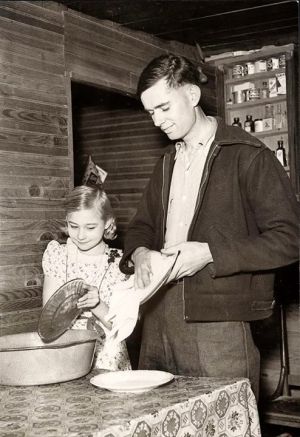One of our staff members is contributing considerably to a News Archiving service at Mu. Any well educated (Masters, PhD or above) users who wish to make comments on news sites, please contact Jim Burton directly rather than using this list, and we can work on maximising view count.
Youth-Adult Marriage

Youth-Adult Marriages (often described with the objectifying and sometimes inaccurate term "child marriage"), have existed throughout history. We have documented evidence of many such marriages in Indian society, but historically, the tradition extends to the Western world and even to the present in Islam.
Youth-Adult Marriage is a divisive topic among MAPs, with many left and libertarian MAPs opposing the idea of any marriage as a legally-recognized concept at any age. Nevertheless, pro-c MAP allies have made the argument that Youth-Adult Marriages are not inherently abusive, and that the institutionalization of abuse is dependent upon whether a culture permits or encourages it. One such argument was mounted on the Heretic TOC blog in 2021:
Today we tend to romanticize marriage, thinking of it only in terms of “love”. This conception, however, risks obscuring what marriage is and what it involves other than “love”. Marriage is not “just a bit of paper”, it’s a contract that bestows recognition by a state, usually privileging the couple with rights that do not apply to unmarried persons. We might, therefore, ask whether MAPs should oppose child marriage by virtue of opposing marriage in general, in terms of equality under the law?
In the 19th century context concerning child brides, Syrett emphasises how marriage facilitated the movement of property / inherited wealth, asserting this to be a major consideration in marriages before the 20th century, particularly among elites. Making sure a man did not marry only to make-off with a girl’s fortune was partly why parents were the final arbiters to “okay” a marriage. Today, the requirement of parental consent to marry under the age of majority persists as a hangover of this provision.
If marriage was simply a dramatized expression of love, a fun ceremony-party where people come together, it becomes much harder to see why intergenerational couples would be prohibited from expressing themselves. At least, in a society where hostility and dismissal (coupled by prison-terms and iatrogenic harm / secondary victimization) were not the a priori response directed at such couples, the practice might find space for cultural sanction.[1]
Those with a religious motivation for defending or condoning Youth-Adult Marriage have also constructed detailed defenses, including from Hindu[2] and Islamic perspectives.[3]
China's Yi people consider the minimum marriageable age for a man to be ten years old, and the minimum for a woman to be nine. In terms of marriageable age, an even number is the best age for the man, and an odd number is the best age for the woman.[4] The ethnic minorities in Guangxi, such as the Zhuang, Miao, Yao and other ethnic minorities, also have a relatively low marriage age, mostly ranging from 7 to 15 years old, and the situation of each tribe is different. Han Chinese who have historically lived around minority areas are also affected and have a relatively low marriage age. After the founding of the Republic of China, the custom of early marriage was suppressed until it was completely banned during the Red China period.[5]
[describe context - legal emancipation of minors, etc]
The incendiary problematics of "child marriage"
As commonly defined, the term "child marriage" has little validity as a legal or ethical construct. It is rather telling that the UN framework and their affiliated NGOs pursue the idea of "child marriage", which may or may not imply arranged marriage and rarely involves children. The "international community" therefore risk abandoning adult women who are subjected to arranged marriages, something which they could make a defensible ethical argument against. After conducting a short literature review, Newgon found widespread evidence of anti "child" (youth-adult) marriage campaigners "overstepping the mark" with respect to their attempts to establish a base of "evidence". Claims made about the effect of "child marriage" on sexual health often recycle old tropes about "teen pregnancy" and unsubstantiated statistics from UN reports. It is impossible to find any evidence that these figures are based upon sound methodology and adequately controlled experimental designs. For example, one such paper (written by an activist Physician with no academic credentials) is used frequently by Wikipedia to make multiple such unsupported claims.[6]
Since many countries have laws in place allowing girls in particular to be married in their mid-teens, the concept also can not be said to have any validity as a global construct. Such marriages are often necessary for economic and cultural reasons. It appears the idea of combating "child marriage" is used to enforce western imperialism and define legal relationships in "lesser" cultures arbitrarily as a form of discrimination or violence against girls and women. The effects of this are to promote adherence to a westernized model of "education" that undermines local/traditional family customs and reduces the ability of communities to resist occupation by western financial elites. This increases their economic dependency upon the US Dollar reserve currency. It is highly unlikely that keeping all girls in education is a "scaleable" or sustainable solution for these economies, at least for as long as they remain US dependencies with little economic independence. This leaves said economies in a "vicious circle" whereby they are left with a "problem" (defined by the west) that can never be solved by the western interventions offered as a solution. The winners in this scenario are western NGOs that seek rent off the back of developing world problems.
Gallery
-
Eunice and Charlie Johns
-
Eunice and Charlie Johns (continued)
-
Eunice and Charlie Johns (continued)
See also
- Republicans are the real pedophiles - Cliché talking point, in which "Child Marriage" (usually of late teens) is always invoked.
References
[Insert cats]


